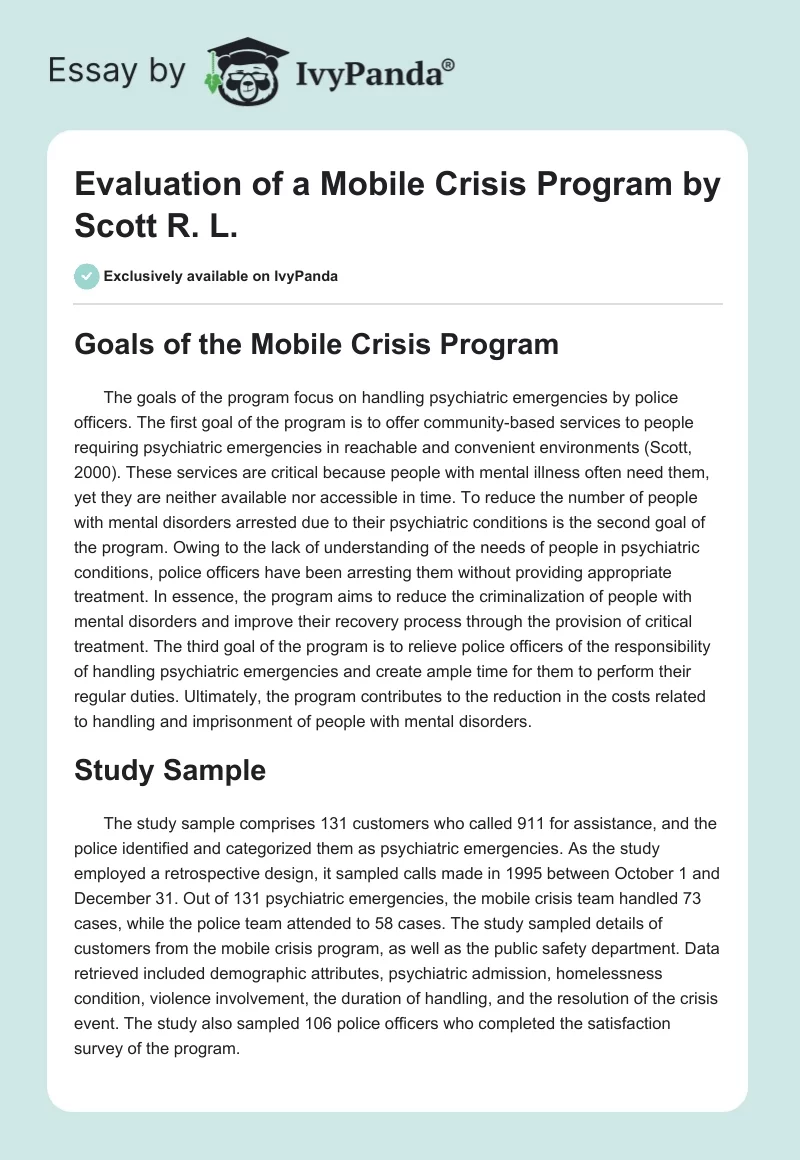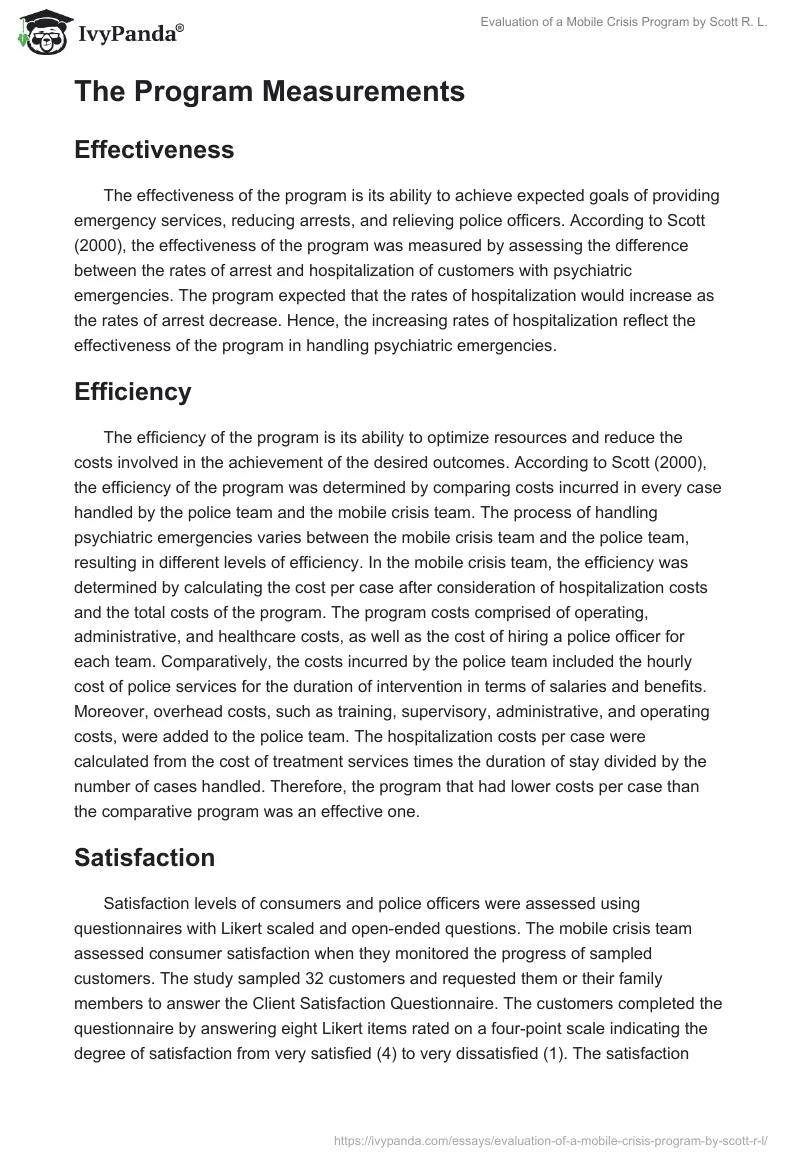Goals of the Mobile Crisis Program
The program’s goals focus on police officers handling psychiatric emergencies. The program’s first goal is to offer community-based services to people requiring psychiatric emergencies in reachable and convenient environments (Scott, 2000). These services are critical because people with mental illness often need them, yet they are neither available nor accessible in time.
Reducing the number of people with mental disorders arrested due to their psychiatric conditions is the second goal of the program. Owing to the lack of understanding of the needs of people in psychiatric conditions, police officers have been arresting them without providing appropriate treatment. In essence, the program aims to reduce the criminalization of people with mental disorders and improve their recovery process through the provision of critical treatment. The third goal of the program is to relieve police officers of the responsibility of handling psychiatric emergencies and create ample time for them to perform their regular duties. Ultimately, the program contributes to the reduction in the costs related to handling and imprisonment of people with mental disorders.
Study Sample
The study sample comprises 131 customers who called 911 for assistance, and the police identified and categorized them as psychiatric emergencies. As the study employed a retrospective design, it sampled calls made in 1995 between October 1 and December 31. Out of 131 psychiatric emergencies, the mobile crisis team handled 73 cases, while the police team attended to 58 cases. The study sampled details of customers from the mobile crisis program, as well as the public safety department. Data retrieved included demographic attributes, psychiatric admission, homelessness condition, violence involvement, the duration of handling, and the resolution of the crisis event. The study also sampled 106 police officers who completed the satisfaction survey of the program.
The Program Measurements
Effectiveness
The effectiveness of the program is its ability to achieve expected goals of providing emergency services, reducing arrests, and relieving police officers. According to Scott (2000), the effectiveness of the program was measured by assessing the difference between the rates of arrest and hospitalization of customers with psychiatric emergencies. The program expected that the rates of hospitalization would increase as the rates of arrest decrease. Hence, the increasing rates of hospitalization reflect the effectiveness of the program in handling psychiatric emergencies.
Efficiency
The efficiency of the program is its ability to optimize resources and reduce the costs involved in the achievement of the desired outcomes. According to Scott (2000), the efficiency of the program was determined by comparing costs incurred in every case handled by the police team and the mobile crisis team. The process of handling psychiatric emergencies varies between the mobile crisis team and the police team, resulting in different levels of efficiency. In the mobile crisis team, the efficiency was determined by calculating the cost per case after consideration of hospitalization costs and the total costs of the program. The program costs comprised of operating, administrative, and healthcare costs, as well as the cost of hiring a police officer for each team. Comparatively, the costs incurred by the police team included the hourly cost of police services for the duration of intervention in terms of salaries and benefits. Moreover, overhead costs, such as training, supervisory, administrative, and operating costs, were added to the police team. The hospitalization costs per case were calculated from the cost of treatment services times the duration of stay divided by the number of cases handled. Therefore, the program that had lower costs per case than the comparative program was an effective one.
Satisfaction
Satisfaction levels of consumers and police officers were assessed using questionnaires with Likert scaled and open-ended questions. The mobile crisis team assessed consumer satisfaction when they monitored the progress of sampled customers. The study sampled 32 customers and requested them or their family members to answer the Client Satisfaction Questionnaire. The customers completed the questionnaire by answering eight Likert items rated on a four-point scale indicating the degree of satisfaction from very satisfied (4) to very dissatisfied (1). The satisfaction scores ranged from 8 to 32, depending on the level of satisfaction of each customer. Besides, the satisfaction level of each customer was assessed using open-ended questions, which inquired if the program delivered the required services and obtained a positive review.
The satisfaction levels of the police team were determined using a designed survey instrument to rate the performance of the mobile crisis team on a five-point Likert scale ranging from very satisfied (5) to very dissatisfied (1). The police team also provided their suggestions and comments regarding the extent of their satisfaction with the program of the mobile crisis team. One-hundred and six police officers who were present in three consecutive shifts of the mobile crisis program managed to complete the survey, and their responses were captured.
Validity of Measurements
The use of the Client Satisfaction Questionnaire in assessing the level of satisfaction among consumers provides a valid measure. The questionnaire comprises of 8 Likert items that measure on a four-point scale showing the proportionate level of satisfaction from very dissatisfied (1) to very satisfied (4). According to Kelly et al. (2017), the Client Satisfaction Questionnaire is not only a reliable but also a valid instrument because it provides accurate and consistent results across various settings. The application of this questionnaire in the collection of data is advantageous since it generates valid and reliable findings concerning the satisfaction level of customers in the mobile crisis program. Moreover, the open-ended questions provided additional information that supports scaled responses.
The survey of the police team is also valid because the author designed questions to reflect factors that determine satisfaction among police officers working in specified conditions. In essence, the survey instrument captures numerous factors that conceptualize satisfaction and meet the requirement of content validity. The use of a five-point Likert scale makes the survey instrument sensitive to the measurement of satisfaction. DeCastellarnau (2017) recommends that the rating scale should be simple for respondents to provide appropriate answers and sensitive to capture subtle variations. Additionally, comments and suggestions sought by the open-ended questions improved the validity of the survey instrument used to measure police satisfaction.
Outcome Evaluation
The study presents the outcome form of evaluation in the assessment of the mobile crisis program. The focus of the outcome evaluation is to assess the capability of a program to achieve the desired objectives and goals. The outcome evaluation assesses results generated by a program and compares them to expected endings. In the outcome evaluation of the mobile crisis program, the study appraised effectiveness, efficiency, and satisfaction as key results. The effectiveness was evaluated by the number of customers hospitalized when compared to those who were arrested during psychometric emergencies. An outcome of increased hospitalization and decreased arrest shows that the program is effective in handling psychiatric emergencies. The efficiency was evaluated using the cost per case in the interventions of the mobile crisis team and the police team. A reduction in costs per case indicates that the program is effective in helping the criminal justice system address psychiatric emergencies. The satisfaction of customers was assessed by interviewing them, their families, and police officers. Thus, the outcomes of the program determined its effectiveness and efficiency in handling psychiatric emergencies, as well as the satisfaction level of customers.
Comment on the Quality of the Research Design
The critical analysis of the research design shows it is of high quality because it incorporated scientific protocols. The study employed a retrospective research design in examining the impact of the mobile crisis program on the effectiveness, efficiency, and satisfaction of customers who required psychiatric emergencies. The advantages of the retrospective design are that it is convenient, cheap, and allows the assessment of numerous outcomes. However, the design is disadvantageous because some attributes are not measurable, researchers cannot manipulate exposure, selection biases are common, and much data is necessary. To overcome the disadvantage of selection bias, the study applied the strategy of a natural experiment (Scott, 2000). The study also addressed the requirement of extensive data by replicating the study among the police team for comparative purposes. Therefore, modification of the retrospective study improved the quality of the research design, for it enhanced the representative of the study population and minimized the effect of selection bias.
Moreover, the analysis of the methods employed in data collection suggests that the study used a superior research design. In the collection of data that measure the effectiveness of the program, the study utilized the rates of hospitalization and arrest. These rates are valid outcomes because they assess how the police team and the mobile crisis team handle psychiatric emergencies. The assessment of efficiency used a valid measure of cost per case. The availability of secondary data regarding expenses of treatment, remuneration, and administration permitted accurate calculation of costs per case. In the assessment of customer satisfaction, the study used an established questionnaire, which is valid and reliable in various research settings. The use of a designed questionnaire in the assessment of the satisfaction among the police officers was valid and consistent because it was designed with Likert items on a five-point scale to improve the sensitivity of data collection. Ultimately, the application of inferential statistics in the generation of findings permitted the unbiased determination of the significance of variations in efficiency, effectiveness, and satisfaction between the way the mobile crisis team and the police team handle psychiatric emergencies.
Conclusions about Internal Validity
The study has a high internal validity because the research design and methodologies of data collection and analysis are scientifically sound. The researcher noted the weaknesses of the retrospective design and managed to address them by minimizing the selection bias and introducing a control group to the study. The research instruments used in the assessment of the satisfaction level among customers and the police are effective in enhancing the internal validity of the study. By following the methodologies, other researchers can replicate the study and generate similar findings.
References
DeCastellarnau A. (2017). A classification of response scale characteristics that affect data quality: A literature review. Quality & Quantity, 52(4), 1523-1559. Web.
Kelly, P. J., Kyngdon, F., Ingram, I., Deane, F. P., Baker, A. L., & Osborne, B. A. (2017). The Client Satisfaction Questionnaire-8: Psychometric properties in a cross-sectional survey of people attending residential substance abuse treatment. Drug and Alcohol Review, 37(1), 79-86. Web.
Scott, R. L. (2000). Evaluation of a mobile crisis program: Effectiveness, efficiency, and consumer satisfaction. Psychiatric Services, 51(9), 1153-1156.


